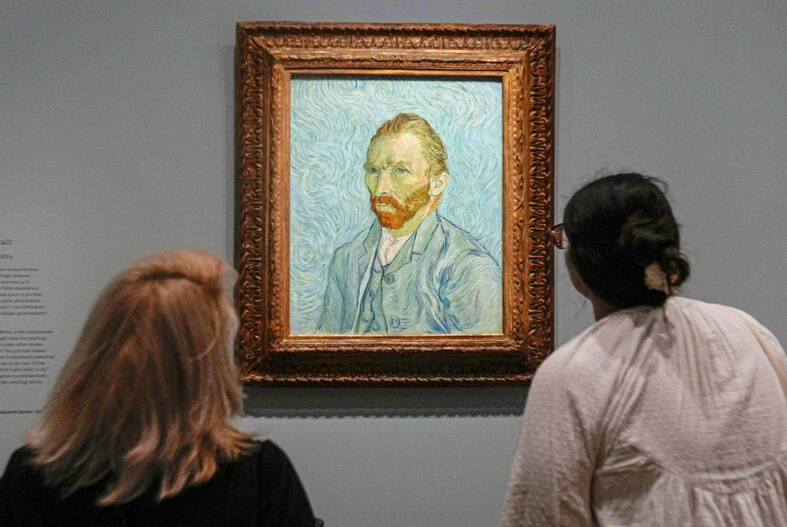AI Vincent Van Gogh is patient but unimpressed by yet another question about his chopped-off ear.
“I apologize for any confusion but it seems you are mistaken,” says the great painter’s avatar, in the sort of testy tone familiar to anyone who has toyed with AI language models. “I only cut off a small part of my ear lobe,” he insists (in fact, there are multiple accounts of how the artist mutilated his ear).
The artificial intelligence Van Gogh appears on a video screen at the end of a blockbuster exhibition at the Musee d’Orsay in Paris. The exhibition, running until February, is dedicated to the final weeks of his life in the village of Auvers-sur-Oise, just north of the French capital. Van Gogh shot himself with a rusty pistol in 1890 aged 37. It took him two days to die.

Photo: AP
But the AI Vincent is surprisingly well-versed in 21st century therapy-speak.
“While I did face mental health struggles, my move to Auvers-sur-Oise was not motivated by a desire to end my life,” he says.
As the 40 or so paintings at the Orsay exhibition make clear, his final weeks were extraordinarily prolific, full of masterpieces including The Church at Auvers, Wheatfield with Crows and his very last, Tree Roots.
All the more surprising is that this period has never been given a dedicated showcase, said Christophe Leribault, Musee d’Orsay president.
VIRTUAL VINCENT
Among the highlights is a room dedicated to his “double-square” panoramas, a technical revolution in which he used very long and thin canvases, prefiguring the wide-screen landscapes of cinema. It is perhaps fitting, then, that the show ends with modern technologies, which have become increasingly common as exhibitions try to pull in young audiences.
As well as the Van Gogh chatbot, visitors can also don a virtual reality headset to enter the kitchen of Dr Gachet, where Van Gogh spent time in his final weeks, take a surreal trip around an enormous version of his paint palette and plunge into the tree roots of his final painting. The state-of-the-art helmet from Taiwanese firm Vive Arts can track the hands of users — without the need for handheld controllers — allowing them to pick up items in the virtual world and play with globules of paint. The AI, by contrast, displays some of the teething problems of the nascent tech.
Asked about his favorite color, AI Vincent is very certain (yellow). But he struggles to recognize people in his life, failing to pick up the name of Dr Gachet when asked by a French journalist.
“It recognizes words in the French language but we still need to fine-tune the AI so that it understands proper nouns better,” said Christophe Renaudineau, head of Jumbo Mana, the Strasbourg start-up which designed the machine.
“This experiment will allow us to improve the model,” he added.

In the March 9 edition of the Taipei Times a piece by Ninon Godefroy ran with the headine “The quiet, gentle rhythm of Taiwan.” It started with the line “Taiwan is a small, humble place. There is no Eiffel Tower, no pyramids — no singular attraction that draws the world’s attention.” I laughed out loud at that. This was out of no disrespect for the author or the piece, which made some interesting analogies and good points about how both Din Tai Fung’s and Taiwan Semiconductor Manufacturing Co’s (TSMC, 台積電) meticulous attention to detail and quality are not quite up to

April 21 to April 27 Hsieh Er’s (謝娥) political fortunes were rising fast after she got out of jail and joined the Chinese Nationalist Party (KMT) in December 1945. Not only did she hold key positions in various committees, she was elected the only woman on the Taipei City Council and headed to Nanjing in 1946 as the sole Taiwanese female representative to the National Constituent Assembly. With the support of first lady Soong May-ling (宋美齡), she started the Taipei Women’s Association and Taiwan Provincial Women’s Association, where she

Chinese Nationalist Party (KMT) Chairman Eric Chu (朱立倫) hatched a bold plan to charge forward and seize the initiative when he held a protest in front of the Taipei City Prosecutors’ Office. Though risky, because illegal, its success would help tackle at least six problems facing both himself and the KMT. What he did not see coming was Taipei Mayor Chiang Wan-an (將萬安) tripping him up out of the gate. In spite of Chu being the most consequential and successful KMT chairman since the early 2010s — arguably saving the party from financial ruin and restoring its electoral viability —

It is one of the more remarkable facts of Taiwan history that it was never occupied or claimed by any of the numerous kingdoms of southern China — Han or otherwise — that lay just across the water from it. None of their brilliant ministers ever discovered that Taiwan was a “core interest” of the state whose annexation was “inevitable.” As Paul Kua notes in an excellent monograph laying out how the Portuguese gave Taiwan the name “Formosa,” the first Europeans to express an interest in occupying Taiwan were the Spanish. Tonio Andrade in his seminal work, How Taiwan Became Chinese,